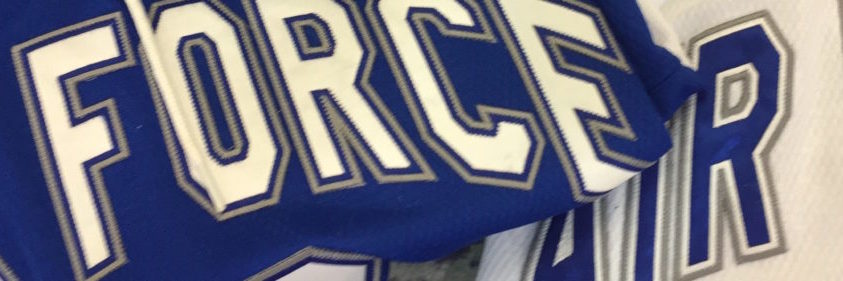Upon further review: Air Force’s 2021-22 hockey season offered the promise of bigger things being on the horizon.
As you might recall, the Falcons entered the campaign as one of Division I’s youngest teams and carried modest expectations (namely a predicted ninth-place finish in Atlantic Hockey).
By any measure, finishing with a 16-17-3 record and reaching the AHA championship game were massive steps.
Here are some of the most notable things to me as I reflected on my sixth season covering the team and seventh writing about it.
Balanced attack
How can a service academy thrive in D-I? Excellent scoring balance is good place to start. The Falcons had that, and they weren’t overly reliant on their power play to put up points (which earns brownie points with me). Five players had 20 or more points, led by sophomore Will Gavin’s 29 and 16 goals (second in AHA). And four defensemen had 16 or more points, led by junior Brandon Koch’s 25. Koch was a third-team all-conference pick.
The top line of Willie Reim (25 points), Andrew DeCarlo (15) and Nate Horn (22) accounted for 62 points. The second line of Gavin, Clayton Cosentino (24) and Parker Brown (19) had 72.
The third prong to the offensive attack was the defense – the top-four combination of Brandon Koch (25 points), Sam Brennan (19), Mitchell Digby (18) and Luke Rowe (16) had 78 points.
No experience required
The Falcons, who rostered 18 underclassmen, had to rely on their freshmen … a lot. And the newcomers played outstanding.
Cosentino (24 points) and DeCarlo (15) centered the top two lines. Austin Schwartz (8) centered the fourth line, and along with Cosentino killed penalties. Lucas Coon had 10 points on the third line and saw power-play time. All four played all 36 games, as did defenseman Digby, who was also received power-play time and 18 points. Smooth skating Jasper Lester showed positional versatility and poise, and he was selected one of the team’s most improved players (along with junior defenseman Andrew Kruse). Another freshman defenseman, Drake Usher, also played 22 games.
The encouraging part of the group was its versatility. Several could – and had to – play in multiple situations. The moments didn’t seem too big for them.
Cosentino and Digby both made the AHA all-rookie team.

Air Force center Clayton Cosentino. Photo courtesy of Air Force Athletics
Good health
Injuries did not wreck Air Force nearly as much as in some recent seasons. . Just two players expected to play nightly – center Ty Pochipinski and defenseman Dalton Weigel – missed substantial amounts of time. Both juniors would have helped. But that is nowhere near the carnage levels the Falcons have sustained some years. Pochipinski, who scored both of his goals in a victory against Colorado College (his former team), only played seven games. Weigel saw action in five. The physical Usher, who played 22 games, also was injured toward the season’s end.
The lineup continuity had to factor into the team’s improvement as the season wore on. The top 12 forwards all played 31 or more games. The top five defensemen all played 34 games or more.
No crazy swings
Young team means hot and cold streaks, right? Not this season.
The Falcons never went on any crazy long slumps. They dropped as many as three games in a row just twice. They only sustained three series sweeps – vs. national champion Denver, vs. league champion AIC and one puzzling one, vs. Holy Cross at home, though the first of those losses came in overtime. Twice AFA had four-game winning streaks, the latter when it really counted – in the season finale vs. RIT to clinch a first-round AHA playoff bye and stretching all the way to the league championship game vs. AIC.
Part 2: Close calls helped define this team
©First Line Editorial 2022


